“International Shibori Symposium 2018 Review (Part II)” by Astrid Bennett & Kim Eichler-Messmer
August 8, 2018
Held earlier this summer, the 11th International Shibori Symposium (11ISS) was an exciting and densely-packed exploration of the dyeing traditions of Japan. 125 participants came from international countries, with another equal number from Japan. The schedule included workshops and events in the shibori village of Arimatsu; the safflower harvest, other natural dye and sashiko workshops in the Yamagata region of northern Japan; plus contemporary shibori exhibitions, workshops and studio visits in Nagoya and Tokyo. With the scope of the itinerary, participants could choose to attend the full symposium, or either the first or second half. Astrid Bennett was able to attend the Inland Sea Tour and the first half of the Symposium and report on those in Part I of II blog articles covering the 11ISS. Kim Eichler-Messmer attended the full Symposium and reports in Part II on the Yamagata (second) portion of the Symposium.
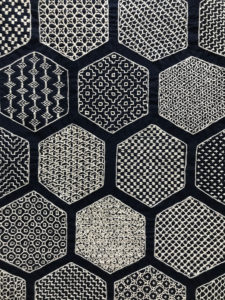
An example of the exceptional Sashiko found in the Yamagata region of Japan.
Continuing the narrative now is Kim Eichler-Messmer, who traveled north to Yonezawa in Yamagata Prefecture for the second half of the Symposium. There the group stayed in Ryokans, traditional Japanese inns with tatami-matted rooms, communal hot springs baths, and traditional Japanese meals. On the only full day in Yonezawa, they attended workshops taught by local artisans. Kim reports, “I had a natural dye workshop in the morning at the studio and farm of the Yamagishi family of natural dyers, silk spinners, and weavers. Master dyer Kōichi Yamagishi led the dye workshop where we could choose from a variety of dyes to use including fresh leaf indigo, Japanese Akane madder, and pomegranate. I was able to rinse my fresh leaf indigo dyed scarf in the mountain stream behind the studio. In the afternoon I attended a workshop on Harakata sashiko taught by Kiyoko Endo.”
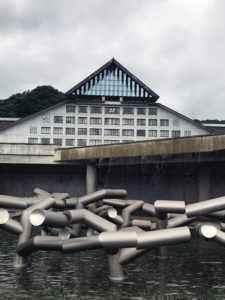
Tohoku University.
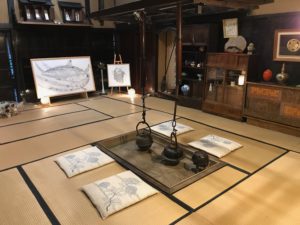
Ryokan Tea Room, where 11ISS attendees stayed.
From Yonezawa, they traveled to Tohoku University of Art and Design in Yamagata City, attending a dinner and a special Noh theater performance about Safflower. On their first full day in Yamagata, their group left the hotels at 5:20 am to attend a safflower harvest at the University’s safflower field. Dr. Kazuki Yamazaki led them through the rain to the safflower fields. There they learned that only the flowers that are starting to turn red should be harvested, and it is best to do it in the early morning because the humidity from the night will soften the plants, making them less likely to poke you. After harvesting, they learned how to process the safflower petals into “beni-mochi” dye patties. Later in the day they witnessed a demonstration on how to create yellow, orange, red, and hot pink dye from the safflower dye.
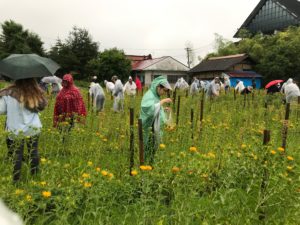
Early morning safflower harvest with 11ISS attendees.
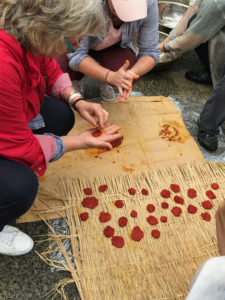
Making beni mochi (safflower) patties for dyeing.
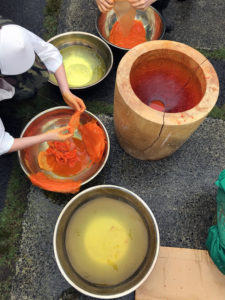
Using fresh safflower to make orange.
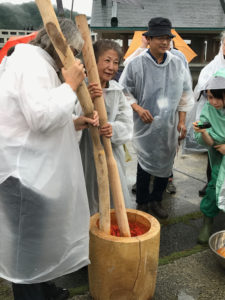
Processing safflower petals.
New Beat the student exhibition, was also held at Tohoku University. Kim describes it as a truly excellent exhibition with work from students all over the world. “Of the 11ISS-sponsored exhibitions, this was my favorite because there was such a variety of materials, processes, formats, and viewpoints.”
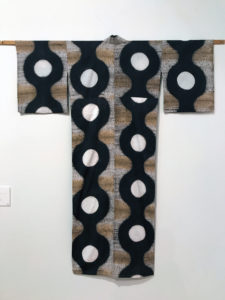
Raindrops student work by Sawai Miyuu from Japan.
She also loved the exhibition of Tsugaru Kogin sashiko. “This form of sashiko is unlike any I had seen before. The stitches are done so densely that at first it looks like the design is woven into the cloth.” This poetic description, written by Muneyoshi Yanagi in 1932, hung at the entrance to the exhibition: “The nameless women of Tsugaru, you have done well to leave us this wonderful heritage. Hemp and cotton were the materials for clothes for the common people, banned from using silk. But you gave birth to this awesome beauty, amidst oppressive prohibition. Should it be called good fortune amidst bad fortune, or is it bad fortune despite good fortune? People gave birth to this beauty to reflect their lives. Your life is the path along which art ought to follow. We are drawn to its beauty. We learn from its lessons.”
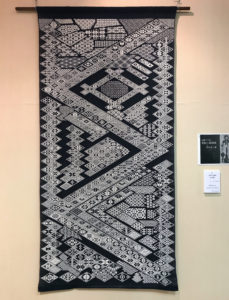
Kogin sashiko by Reiko Nakamura.
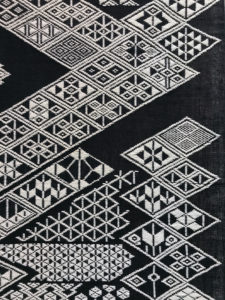
Kogin sashiko by Reiko Nakamura (detail).
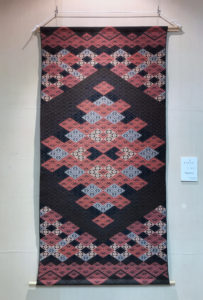
Kogin sashiko by Nobu Hara.
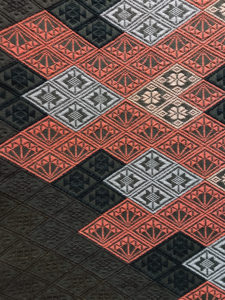
Kogin sashiko by Nobu Hara (detail).
Prior to the Symposium itself, the Inland Sea Tour started with a trip to the island of Shodoshima, where we visited 4 out of 88 Buddhist Pilgrimage sites, as well as Yamaroku, a fifth generation artisanal soy sauce maker. Japan has 7000 islands, 3000 of which are located in the Inland, or Seto, Sea. We then traveled by bus and ferry, to the “art site” islands of Inujima, Teshima and Naoshima. The mix of nature, sounds of sea and birds, smells and contemporary art was powerful. One could easily spend a full day on each of these islands.
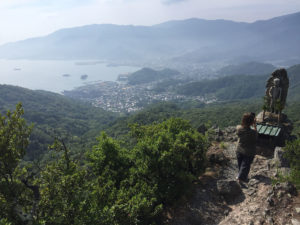
On Shodoshima’s Pilgrimage Route of 88 Shrines.
Inujima is the site of the Inujima Museum, set in a former copper smelting plant, one large art installation involving perceptual tricks from mirrors and shafts of light in low-light situations. The island also houses 5 art house projects by leading architects, nestled in and around traditional village houses. Visiting them took you on well-marked trails through the villages, which became a rich visual experience. The next island, Teshima, is home to the Teshima Art Museum and more art houses. Like most of the larger museums, the Teshima did not allow photography, but it was a deeply felt experience in an amazing outdoor space.
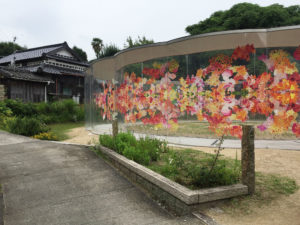
Art House Projects on Inujima, one of many contemporary art projects and museums on various islands.
Finally, we traveled to Naoshima, where we stayed at the well known Benesse House for two nights. The Benesse is an upscale hotel within a museum. Naoshima is also home to the more informal Art House Projects in the town of Honmura, and the monumental Lee Ufan Museum and Benessee Art Museum up the hillside. I was particularly impressed with the Lee Ufan Museum, with its particular combination of art, video, sculptural stone. Installations at the sea along the road completed the experience, which for me also included some drawing and photography of one of my pieces on the pier. The smell of the sea along with the kelp beds and small fish was evocative.
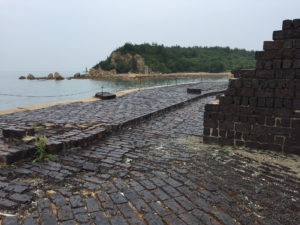
The outside of the Inujima Museum, a former copper smelting plant.
Next day we traveled to Kyoto via train, where we briefly explored the compelling contemporary architecture of the Kyoto train station. Our main stop was the Kitano Shrine monthly market, with its vintage kimono and other treasures, and the Nishijin Weaving Center, where a kimono show showcased contemporary kimono made by the factory and a loom was in operation for visitors to see.
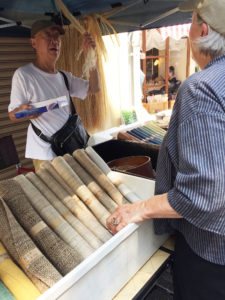
Visiting Kyoto’s monthly Kitano Shrine market, with vendor selling hemp products he and his wife grow, dye and weave.
This provides only a brief introduction to the 11th Annual International Shibori Symposium in Japan. For many more details and photos in 6 separate blog posts, visit Astrid Hilger Bennett’s website.

1 Comment
Yoshiko Iwamoto Waa says
August 17, 2018 at 11:42 pm
What an amazing summary of your incredible time in Japan with the 11th ISS. Thank you for sharing so eloquently the experience the World Shibori Network staff and our colleagues in Japan worked so hard for. It is heartening and reassuring that we all embraced the time in Japan so thoroughly. Thank you, Astrid and Kim. Yoshiko I. Wada, Co-Chair of the 11ISS Japan.
Related Blog Articles
11iss
“International Shibori Symposium 2018 Review (Part I)” by Astrid Bennett & Kim Eichler-Messmer